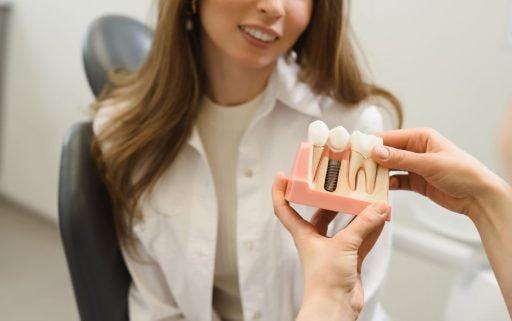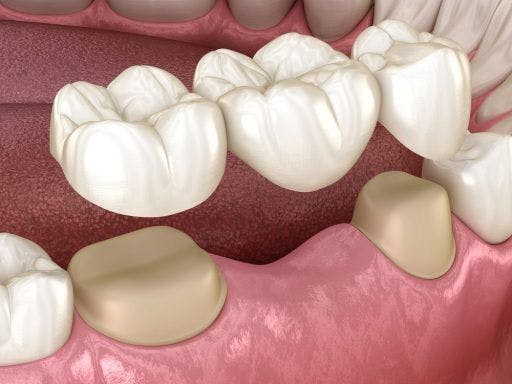Getting a tooth replacement can be anxiety-inducing, especially if you don’t know what to expect from the treatment. How do you know if you need it? What are the pros and cons of each method? Can a tooth replacement impact your quality of life? Here, you’ll get the answers to your most pressing questions, learn more about the benefits, and explore the different options available.
Why would you need a tooth replacement?

Losing a tooth in adulthood might seem like no big deal, but that’s a common misconception. Remember – a complete set of teeth is essential to preserving your mouth’s structure and health. That’s why missing tooth replacements aren’t something you can put off for later. Get one when you need one ASAP!
What happens when you lose a tooth or multiple teeth and neglect to fill the gaps? Well, they can compromise your oral functions (such as chewing and biting) and put you at greater risk for tooth decay and gum disease. The remaining teeth may gradually shift into the open spaces, leading to misalignment and a bad bite.
Missing teeth can also give your face a “sunken” appearance. In a Biology study, researchers concluded that missing permanent teeth lead to a more concave facial profile and a shorter face. Having hollow or gaunt cheeks can make someone appear older than they are, which can impact their self-confidence.
What can cause teeth to fall out?
Several factors can result in tooth loss. Advanced tooth decay may render some teeth unsalvageable with fillings or crowns, requiring an extraction. Periodontal (gum) disease is another common cause since it damages the supporting bone and tissues around teeth.
Older adults are particularly vulnerable to tooth loss because they’re at greater risk for these oral health problems. Traumatic injuries like sports accidents, certain medical and genetic conditions, and lifestyle habits like chronic smoking are also significant causes.
Common tooth replacement options for missing teeth

The good news? Tooth replacement is relatively straightforward! If you practise proper oral hygiene and have healthy gums, the experience should be smooth and painless. It helps to visit your dentist once or twice yearly so they can catch issues early and advise you on preventing tooth loss.
But in case you need it, these are your options to replace missing teeth. As always, consult your dentist to determine the most suitable approach for your case.
Option 1: Dental implants
Dental implants are screw-shaped titanium or ceramic devices that mimic the tooth root. A specialist surgically fixes them onto the jaw to create a strong and stable foundation for artificial teeth. Implants don’t require support from adjacent teeth and can last for decades with proper maintenance.
A Clinical Implant Dentistry and Related Research study even found that they boast a higher success rate (98.5%) than dentures (92%). Plus, they look like the real deal, and have the same texture as regular teeth. But expect to pay around AUD$3,000 for a single implant.
Given these, implants are some of the most sought-after fixes for missing teeth. Unfortunately, not everyone qualifies for them. You’ll need to undergo a comprehensive dental examination to determine your eligibility. Having adequate bone density and a healthy gum condition are necessary for implants.
Option 2: Dentures
Unlike implants, dentures are removable dental prosthetics made of porcelain or resin. They’re custom-made to fit into your mouth, filling the gaps seamlessly. They have the same look and function as natural teeth but may take some getting used to.
Dentures are also for everyone, even if your teeth and jaw aren’t in the perfect shape. There are different types for different needs. Full dentures replace entire rows of missing teeth, while partial dentures are for those with existing teeth. If you go for this option, make sure to remove and clean them daily and avoid wearing the dentures to sleep.
According to the Australian Dental Association, full dentures cost around AUD$4,000, while partial dentures go for AUD$2,200.
Option 3: Bridges

As their name suggests, dental bridges “bridge” the gaps between teeth. They consist of fixed abutments and pontics. The former acts as anchors on either side of the bridge. They can be existing natural teeth (for traditional bridges) or dental implants with crowns (for implant-supported bridges). Meanwhile, pontics refer to the artificial teeth that slot into the gaps.
Since dental bridges depend on abutments for stability, any decay or damage to them can compromise their supportive abilities. As such, bridges anchored on natural teeth should always be free of plaque and bacteria buildup that threaten their structure.
You can choose this option if you have healthy teeth and gums, free from any diseases. Expect to pay around AUD$3,000 to AUD$5,000 for the entire procedure.
Option 4: Flippers
Implants and bridges are reliable and long-lasting, but they can be pricey – especially if you need to replace multiple teeth. If you’re on a budget, it’s only normal to wonder: what is the cheapest way to replace your teeth? From an affordability standpoint, flippers are your best bet. Their price ranges from AUD$300 to AUD$500.
They’re also known as acrylic temporary partial dentures. They attach to surrounding teeth with clasps or to gums with suction. They’re removable like dentures but not nearly as durable since flippers aren’t a permanent fix. Most patients only use them while recovering from a procedure like tooth extraction.
Can you still wear aligners with replacement teeth?

Undergoing orthodontic treatment with ClearCorrect aligners or other appliances is still possible in many cases. However, some patients may need to get orthodontics prior to replacing a tooth with fixed solutions like implants or bridges. For others, it may be better to get treatment when the replacements are already in place to facilitate alignment. Ultimately, it would depend on your dentist’s recommendation and your goals.
Does replacing a tooth require lifestyle changes?
Yes, as with all things in life, some lifestyle changes may be necessary to preserve the rest of your teeth. Frequently needing to replace natural teeth can be a sign of inconsistent oral hygiene practices, a highly sugary or acidic diet, and missing too many dental checkups. Kicking these bad habits is key to better oral health.
Getting a tooth replacement can make it easier to enjoy your daily life. But it’s still important to stay proactive in maintaining your (remaining) healthy teeth. Brush and floss daily, keep a balanced diet, and visit your dentist regularly. Ask them for advice on what else you can do to keep your existing teeth in excellent form.
References:
Dental Implant Procedures. (2022, March 4). American Academy of Periodontology.
French, D., Ofec, R., & Levin, L. (2021). Long term clinical performance of 10 871 dental implants with up to 22 years of follow-up: A cohort study in 4247 patients. Clinical Implant Dentistry and Related Research, 23(3), 289-297.
Oeschger, E. S., Kanavakis, G., Cocos, A., Halazonetis, D. J., & Gkantidis, N. (2022). Number of teeth is related to craniofacial morphology in humans. Biology, 11(4), 544.



